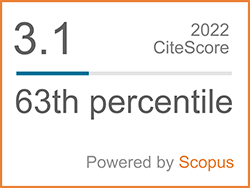Influence and Possibility of Using Limestone Dust Replacement of Sand for Sustainability in Concrete Production
Abstract
Keywords
[1] T. Thapprom, “The study of compressive strength of concrete by using silt stone instead of sand for fine aggregate; A case study on silt stone from Narathiwat stone mine,” Princess of Naradhiwas University Journal, vol.1, no. 2, pp. 28–41, 2009.
[2] C. Choosakul and K. Yongsata, “Compressive strength of mortar using the mineral dust partial replacement in sand,” Rajamangala University of Technology Srivijaya Research, vol. 10, no. 2, pp. 324–332, 2018.
[3] W. Arckarapunyathorn, “Slump and compressive strength of concrete containing recycled aggregate and lime stone dust,” Journal of Engineering RMUTT, vol. 17, no. 1, pp. 149–161, 2019.
[4] G. Aditya and M. T. S. Lakshmayya, “Effective utilization of various industrial waste in concrete for rigid pavement construction—A literature review,” International Journal for Innovative Research in Science & Technology, vol. 3, pp. 65– 73, 2016.
[5] S.-C. Kou and C.-S. Poon, “Properties of concrete prepared with crushed fine stone, furnace bottom ash and fine recycled aggregate as fine aggregates,” Construction and Building Materials, vol. 23, pp. 2877–2886, 2009.
[6] R. Siddique, “Effect of fine aggregate replacement with class F fly ash on the mechanical properties of concrete,” Cement and Concrete Research, vol. 33, pp. 539–547, 2003.
[7] H. Li, F. Huang, G. Cheng, Y. Xie, Y. Tan, L. Li, and Z. Yi, “Effect of granite dust on mechanical and some durability properties of manufactured sand concrete,” Construction and Building Materials, vol. 109, pp. 41–46, 2016.
[8] Y. Aggarwal and R. Siddique, “Microstructure and properties of concrete using bottom ash and waste foundry sand as partial replacement of fine aggregates,” Construction and Building Materials, vol. 54, pp. 210–223, 2014.
[9] A. O. Mashaly, B. N. Shalaby, and M. A. Rashwan, “Performance of mortar and concrete incorporating granite sludge as cement replacement,” Construction and Building Materials, vol. 169, pp. 800–818, 2018.
[10] H. Li, F. Huang, G. Cheng, Y. Xie, Y. Tan, L. Li, and Z. Yi, “Effect of granite dust on mechanical and some durability properties of manufactured sand concrete,” Construction and Building Materials, vol. 109, pp. 41–46, 2016.
[11] A. Danish, M. A. Mosaberpanah, M. U. Salima, R. Fediuk, M. F. Rashid, and R. M. Waqas, “Reusing marble and granite dust as cement replacement in cementitious composites: A review on sustainability benefits and critical challenges,” Journal of Building Engineering, vol. 44, p. 102600, 2021.
[12] S. Singh, R. Nagar, and V. Agrawal, “A review on properties of sustainable concrete using granite dust as replacement for river sand,” Journal of Cleaner Production, vol. 126, pp. 74–87, 2016.
[13] H. Hebhoub, H. Aoun, M. Belachia, H. Houari, and E. Ghorbel, “Use of waste marble aggregates in concrete,” Construction and Building Materials, vol. 25, no. 3, pp. 1167–1171, 2011.
[14] L. G. Li, Z. H. Huang, Y. P. Tan, A. K. H. Kwan, and F. Liu, “Use of marble dust as paste replacement for recycling waste and improving durability and dimensional stability of mortar,” Construction and Building Materials, vol. 166, pp. 423–432, 2018.
[15] J. J. Chen and A. K. H. Kwan, “Adding limestone fines to reduce heat generation of curing concrete,” Magazine of Concrete Research, vol. 64, no. 12, pp. 1101–1111, 2012.
[16] A. K. H. Kwan, M. McKinley, and J. J. Chen, “Adding limestone fines as cement paste replacement to reduce shrinkage of concrete,” Magazine of Concrete Research, vol. 65, no. 15, pp. 942–950, 2013.
[17] J. J. Chen, A. K. H. Kwan, and Y. Jiang, “Adding limestone fines as cement paste replacement to reduce water permeability and sorptivity of concrete,” Construction and Building Materials, vol. 56, pp. 87–93, 2014.
[18] L. G. Li and A. K. H. Kwan, “Adding limestone fines as cementitious paste replacement to improve tensile strength, stiffness and durability of concrete,” Cement and Concrete Composites, vol. 60, pp. 17–24, 2015.
[19] L. G. Li, J. J. Chen, and A. K. H. Kwan, “Roles of packing density and water film thickness in strength and durability of limestone fines concrete,” Magazine of Concrete Research, vol. 69, no. 12, pp. 595–605, 2017.
[20] C. Weerayot, S. Apirak, and K. Supaporn, “Use of limestone dust for concrete in xayaburi hydroelectric power project,” Journal of Thailand Concrete Association, vol. 4, no. 1, pp. 40–51, 2016.
[21] A. B. M. A. Kaish, T. C. Odimegwu, I. Zakaria, and M. M. Abood, “Effects of different industrial waste materials as partial replacement of fine aggregate on strength and microstructure properties of concrete,” Journal of Building Engineering, vol. 35, 2021, Art. no. 102092.
[22] K. Slaiai, “Use of Limestone Powder (LSP) in Concrete in GCC Region,” 2016. [Online]. Available: https://www.linkedin.com/pulse/use-limestonepowder- lsp-concrete-gcc-region-khaldoon-slaiai.
[23] A. Carlos, I. Masumi, M. Hiroaki, M. Maki, and O. Takahisa, “The effects of limestone aggregate on concrete properties,” Construction and Building Materials, vol. 24, pp. 2363–2368, 2010.
[24] Z. Makhloufi, T. Bouziani, M. B´ ed´ erina, and M. Hadjoudja, “Mix proportioning and performance of a crushed limestone sand- concrete,” Journal of Building Material and Structure, vol. 2014, no. 1, pp. 10–22, 2014.
[25] Standard Test Method for Sieve Analysis of Fine and Coarse Aggregates, ASTM C136-95a, 1996.
[26] Testing Hardened Concrete- Part 3: Compressive Strength of Test Specimens, BS EN 12390-3, 2001.
[27] Standard Test Method for Static Modulus of Elasticity and Poisson’s Ratio of Concrete in Compression, ASTM C469, 2014.
[28] A. Hawa, W. Prachasaree, and D. Tonnayopas, “Effect of water-to-powder ratios on the compressive strength and microstructure of metakaolin based geopolymers,” Indian Journal of Engineering & Materials Sciences, vol. 24, pp. 499–506, 2017.
[29] S. Ramjan, W. Tangchirapat, and C. Jaturapitakkul, “Effect of finenesses of fly ash and rice husk ash on compressive strength and expansion of mortar in accelerated mortar bar method,” Journal of Thailand Concrete Association, vol. 5, no. 1, pp. 1–13, 2017.
[30] T. Ji, C. Y. Chen, Y. Z. Zhuang, and J. F. Chen, “A mix proportion design method of manufactured sand concrete based on minimum paste theory,” Construction and Building Materials, vol. 44, pp. 422–426, 2013.
[31] T. Gupta, S. Kothari, S. Siddique, R. K. Sharma, and S. Chaudhary, “Influence of stone processing dust on mechanical, durability and sustainability of concrete,” Construction and Building Materials, vol. 223, pp. 918–927, 2019.
[32] K. Vardhan, S. Goyal, R. Siddique, and M. Singh, “Mechanical properties and microstructural analysis of cement mortar incorporating marble powder as partial replacement of cement,” Construction and Building Materials, vol. 96, pp. 615–621, 2015.
[33] S. Siddique, S. Shrivastava, S. Chaudhary, and T. Gupta, “Strength and impact resistance properties of concrete containing fine bone china ceramic aggregate,” Construction and Building Materials, vol. 69, pp. 289–298, 2018.
[34] W. Shen, Y. Liu, Z. Wang, L. Cao, D. Wu, Y. Wang, and X. Ji, “Influence of manufactured sand’s characteristics on its concrete performance,” Construction and Building Materials, vol. 172 pp. 574–583, 2018.
[35] A. Halicka, P. Ogrodnik, and B. Zegardlom, “Using ceramic sanitary ware waste as concrete aggregate,” Construction and Building Materials, vol. 48, pp. 295–305, 2013.
[36] Guide for Modeling and Calculating Shrinkage and Creep in Hardened Concrete, ACI 318, 2008.
[37] K. Charles, M. Bismark, S. Gnida, and B. Thomas, “Stress-strain characteristics of concrete containing quarry rock dust as partial replacement of sand,” Case Studies in Construction Materials, vol. 7, pp. 66–72, 2017.
DOI: 10.14416/j.asep.2021.11.002
Refbacks
- There are currently no refbacks.






.png)



